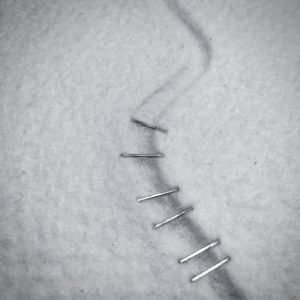Friday Fibers Roundup
July 7, 2017
This week’s Friday Fibers Roundup features an exhibition of Contemporary Native Art, how tennis ball fabric is made, an online vintage pattern library, and so much more!

Eve Camacho-Sanchez Arctic Cracking 2017, wool, staples, 20” x 16”.
1) The exhibition Connective Tissue: New Approaches to Fiber in Contemporary Native Art features contemporary Native American artists who utilize fiber art media and methods to make their statements. The show is on display at the IAIA Museum of Contemporary Native Arts (MoCNA) from July 7, 2017–January 21, 2018.
2) Fragments of woven woolen cloths were recently discovered in copper mines in Southern Israel. These brightly dyed fibers are over 3,000 years old, and are some of the oldest plant dyes that have been found in the Middle East (via Haaretz).
3) Sabrina Gschwandtner’s quilts look like normal fabric from a distance, but once up close, you realize they’re made of 16-mm film, stitched together, and tell a personal story with a social statement (via LA Times).
4) This photo series goes inside the factory where the iconic yellow Wimbledon tennis ball fabric is created (via Daily Mail).
5) College Art Association (CAA) is seeking paper proposals for their 106th Annual Conference in Los Angeles, California on February 21–24, 2018, with proposals due on August 14, 2017.
6) The Textile Center recently had a wonderful tutorial on how to create a Bento Bag by Cecilia Lewis.
7) Artist and designer Anke Domaske created a way to turned spoiled milk into thread, and then eventually into sustainable clothing.
8) The new Issey Miyake Autumn Winter 2017 video campaign was just released and features some beautifully designed garments.
9) Vintage Patterns Wiki now has over 85,300 vintage sewing patterns available for download from various designers and companies. So whether you’re a beginner or advanced sewer, there should be something in there for you (via Inquisitr).
10) Artist Max Alexander creates scientifically accurate depictions of moth species using Shetland wool yarn–turning a usual enemy of knitted wools into a perfect combination (via Creators).


Related Blog Articles
Art Wear
Friday Fibers Roundup: Entertainment & Fashion
Art Wear
“Fringe: On the Edge of Fiber” — Out Now!
Art Wear
Friday Fibers Roundup: Craft & Color